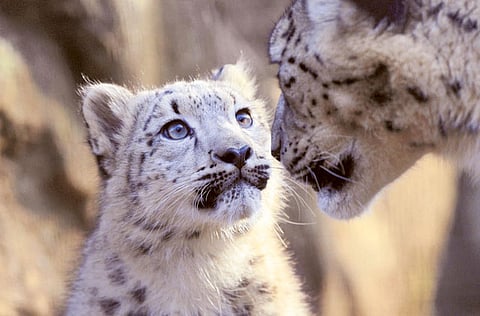The dying roar: endangered Snow Leopards of Pakistan
Snow leopard is considered as an indicator of health for mountainous ecosystem in region

Islamabad: Amongst the family of large cats, Panthera Uncia or the Snow Leopard is one of the most charismatic species. Like most animal species with a majestic skin, the snow leopard is at the verge of extinction. The animal is listed as endangered on the International Union for the Conservation of Nature’s (IUCN) Red List of Threatened Species and Convention on International Trade in Endangered Species (CITES).
Since its most common habitat is Central Asia, the Snow leopard is considered an indicator of health for the mountainous ecosystem in the region. This mountain cat loves to reside 6000 metres above sea level. The best estimate of global snow leopard population is 4,000–6,500. About 200-240 of them live in Pakistan’s Northern Mountains across Khyber Pakhtunkhaw (KPK), Gilgit-Baltistan (GB) and Azad Jammu and Kashmir (AJK).
Pakistan represents the world’s third largest population of snow leopard by size.
The only organisation working for the protection of Snow Leopard in Pakistan is the Snow Leopard Foundation (SLF). The organisation has committed to secure this endangered species targeted for its miraculous beauty. Snow Leopard Foundation is affiliated internationally with the SLT. The majority of the donations for the protection of Snow Leopards come from the United States (US).
Snow Leopard Foundation was registered back in 2005. In their limited resources they have done a tremendous job to save the Snow Leopards and other endangered cats in Pakistan.
The trail cameras technology introduced by them takes random snaps of the Snow Leopard. Just five years back there was only one snapshot of Pakistani Snow Leopard available, now this technology has provided with hundreds of pictures.
According to a new study by the SLT, Snow Leopards in Pakistan are threatened by the poachers from Afghanistan so trans-boundary cooperation is required for the protection of this endangered species.
Another technology used by the SLT is collaring, to locate the presence of a collared Snow Leopard in the Northern areas of the country through Global Positioning System (GPS).
Assistant Professor, Quaid Azam University (QAU) Islamabad, and Programme Director, SLT Dr. Ali Nawaz says,“ In 2006 when we collared a female Snow Leopard to trace the locations where she moves, we were surprised that during the 14-months she wore the collar, the snow leopard, nicknamed Bayad-e-Kohsaar (In the Memory of Mountains), travelled an area of 1,563 kilometres, sharing her time between Pakistan and Afghanistan, summer and winter, respectively. This was something new for even long-time researchers who speculated that the elusive cats require vast areas to survive in some of the world’s most rugged terrain.”
Though hunting snow leopards has been outlawed in Afghanistan since 2002, the Pak-Afghan border is a major place of the Snow Leopard hunting by the international poachers.
Dr. Ali Nawaz states: “With the looming threats of increase in human population, retaliatory killings and urbanisation in the large habitat of the Snow Leopard, this species and other associated biodiversity in the region are threatened with extinction if adaptive measures based on solid empirical evidence and best conservation practices are not proactively pursued.”
The right of the snow leopard and its prey to survive is more generously guaranteed if the right of pastoral communities to optimise their economy is accepted and supported.
The thing to understand is that snow leopard conservation efforts can only succeed when local populations in the habitat are actively engaged, involved and are made to commit to this cause. These joint efforts might just stop the roar from the mountains to fade away in time.
Sign up for the Daily Briefing
Get the latest news and updates straight to your inbox


